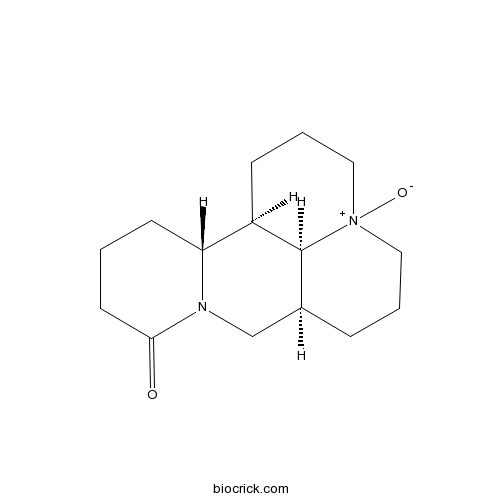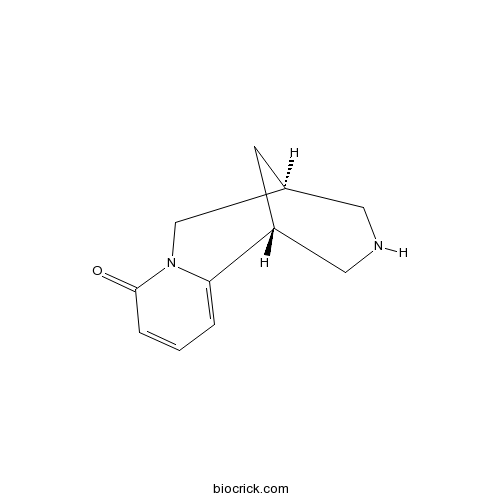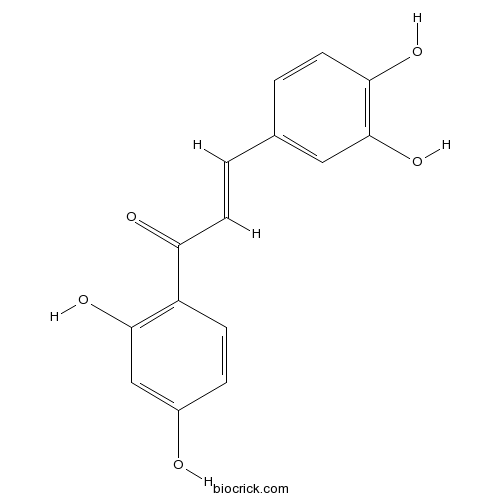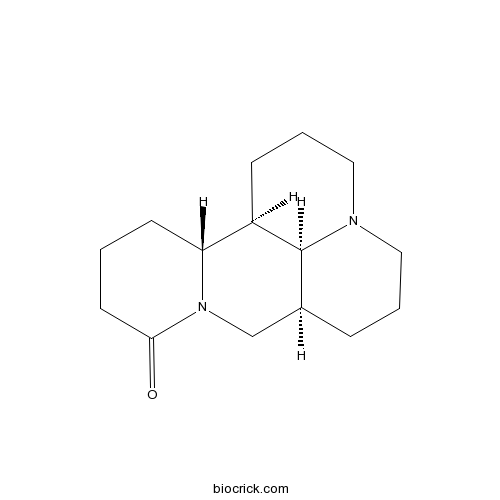Sophora alopecuroides
Sophora alopecuroides
1. The products in our compound library are selected from thousands of unique natural products; 2. It has the characteristics of diverse structure, diverse sources and wide coverage of activities; 3. Provide information on the activity of products from major journals, patents and research reports around the world, providing theoretical direction and research basis for further research and screening; 4. Free combination according to the type, source, target and disease of natural product; 5. The compound powder is placed in a covered tube and then discharged into a 10 x 10 cryostat; 6. Transport in ice pack or dry ice pack. Please store it at -20 °C as soon as possible after receiving the product, and use it as soon as possible after opening.
Natural products/compounds from Sophora alopecuroides
- Cat.No. Product Name CAS Number COA
-
BCN6793
3,4-Dihydrocoumarin119-84-6
Instructions

-
BCN1103
Oxymatrine16837-52-8
Instructions

-
BCN9030
(±)-Nicotine22083-74-5
Instructions

-
BCN6270
Cytisine485-35-8
Instructions

-
BCN2603
Thermopsine486-90-8
Instructions

-
BCN5592
Butein487-52-5
Instructions

-
BCN5650
Matrine519-02-8
Instructions

-
BCN8466
Aloperine56293-29-9
Instructions

-
BCN4249
Sophoridine6882-68-4
Instructions

Aloperine Protects Mice against Bleomycin-induced Pulmonary Fibrosis by Attenuating Fibroblast Proliferation and Differentiation.[Pubmed: 29674691]
Aloperine is a quinolizidine alkaloid extracted from Sophora alopecuroides. It has been proven to alleviate oxidative stress and effectively promote tumor cell apoptosis in mice. Herein, we investigated whether aloperine could also mediate its protective effects on bleomycin (BLM)-induced pulmonary fibrosis. Pathological staining, western blot, RT-PCR and flow cytometry were used to evaluate the impact of aloperine on the development of pulmonary fibrosis. The effect of aloperine on fibroblast proliferation, differentiation and related signaling pathways were next investigated to demonstrate the underlying mechanisms. In the present report, we showed that aloperine provided protection for mice against BLM-induced pulmonary fibrosis as manifested by the attenuated lung injury and reduced fibrosis along with alleviated fibroblast proliferation and differentiation. Additionally, we provided in vitro evidence revealing that aloperine inhibited cellular proliferation in PDGF-BB-stimulated mouse lung fibroblasts by repressed PI3K/AKT/mTOR signaling and fibroblast to myofibroblast differentiation by repressed TGF-β/Smad signaling. Overall, our data showed that aloperine could protect the mice against BLM-induced pulmonary fibrosis by attenuated fibroblast proliferation and differentiation, which indicated that aloperine may be therapeutically beneficial for IPF patients.
A simple and fast quantitative analysis of quinolizidine alkaloids and their biosynthetic precursor, lysine, in Sophora alopecuroides by hydrophilic interaction chromatography coupled with triple-quadrupole tandem mass spectroscopy.[Pubmed: 29573297]
Different parts of Sophora alopecuroides L. (Fabaceae) have historically been used in traditional Chinese medicine for the treatment of dysentery and enteritis. This plant is also utilised as an important resource for industrial preparation of quinolizidine alkaloidal pharmaceuticals.
Streptomyces carminius sp. nov., a novel actinomycete isolated from Sophora alopecuroides in Xinjiang, China.[Pubmed: 29560533]
None
[Research on network pharmacology of alkaloids in Sophora alopecuroides].[Pubmed: 29552827]
It was aimed at exploring the potential pharmacological effects of alkaloids in Sophora alopecuroides by means of network pharmacology in this study. The main alkaloids in S. alopecuroides were collected for analysis of drug properties, prediction of potential targets and screening of signaling pathways. DAVID analysis tool combined with KEGG database was used to annotate and analyze the signaling pathway. The alkaloids-targets-signaling pathways network was built through Cytoscape software. Results showed that 17 alkaloids in S. alopecuroides involved 49 targets (170 times in all) and 22 important signaling pathways. Three nodes in model of network pharmacology were cross-linked, and the metabolic pathways were coordinated and regulated by each other. It indicated that alkaloids in S. alopecuroides may have therapeutic effect on diseases of cancer, metabolic disorder, endocrine system, digestive system, nervous system and so on.
Matrine Induction of ROS Mediated Apoptosis in Human ALL B-lymphocytes Via Mitochondrial Targeting[Pubmed: 29481011]
Acute lymphoblastic leukemia (ALL) is one of the most common malignancies among children, characterized by mass production of leukemic blasts. Chemotherapy is the first step in routine treatment, although it may evoke considerable side effects. Matrine, an alkaloid extracted from a Chinese herb, Sophora alopecuroides flavescens Ait, may be protective. Several investigations have indicated pro-apoptotic and anti-proliferative effects in a diverse range of cancer cells.
Liver, blood microdialysate and plasma pharmacokinetics of matrine following transdermal or intravenous administration.[Pubmed: 29442052]
Matrine is contained in several herbs used in traditional Chinese medicine, named Sophora alopecuroides, Sophora flavescens or Sophora subprostrata. In vitro and in vivo studies have focused on the treatment of chronic hepatitis or liver fibrosis using matrine. However, little is known about its liver pharmacokinetic profile. In this study pharmacokinetics of matrine in rat organs and tissues, such as liver, blood and skin were studied after intravenous (40 mg/kg) or transdermal administration (6 mg/cm2, 5 cm2). Samples were collected at timed intervals for measurement of matrine by a HPLC-UV method. The pharmacokinetic parameters were calculated by non-compartmental analysis using DAS 2.0. The AUC(0-t) values in the liver, blood microdialysates and plasma after intravenous administration were 395.91±74.48, 848.86±146.35 and 1304.07±305.92 min·mg/l, respectively. Following transdermal administration, the AUC(0-t) value in the liver, blood, plasma and skin microdialysates were 695.30±233.79, 1096.07±390.71, 2767.57±518.48 and 42735.77±27938.33 min·mg/l, respectively. Here, we show a promising delivery system for matrine that could replace traditional administration, and a better understanding of the transdermal pharmacokinetics of matrine, which may be helpful for further clinical and laboratory studies.
Enhanced ultrasound-assisted enzymatic hydrolysis extraction of quinolizidine alkaloids from Sophora alopecuroides L. seeds.[Pubmed: 29236225]
Quinolizidine alkaloids are the main bioactive components in Sophora alopecuroides L. This study reports a novel ultrasound-assisted enzymatic hydrolysis method for the extraction of these important alkaloids. Box-Behnken design, a widely used response surface methodology, was used to investigate the effects of process variables on ultrasound bath-assisted enzymatic hydrolysis (UAEH) extraction. Four independent variables, pH, extraction temperature (°C), extraction time (min) and solvent-to-material ratio (mL/g), were studied. For the extraction of sophocarpine, oxysophocarpine, oxymatrine, matrine, sophoramine, sophoridine and cytisine, the optimal UAEH condition was found to be a pH of 5, extraction temperature of 54 °C, extraction time of 60 min and solvent-to-material ratio of 112 mL/g. The experimental values obtained under optimal conditions were fairly consistent with the predicted values. UAEH extraction was then compared with reflux heating, enzymatic extraction and ultrasound-assisted extraction. Of these extraction methods, UAEH extraction under optimal conditions produced the highest yield for seven types of alkaloids. In addition, UAEH extraction resulted in lower ingredient degradation than reflux heating extraction.
Oxysophoridine rescues spinal cord injury via anti‑inflammatory, anti‑oxidative stress and anti‑apoptosis effects.[Pubmed: 29207118]
Oxysophoridine (OSR) is an alkaloid extracted from Sophora alopecuroides L and has various pharmacological activities. The present study aimed to investigate the protective effects and underlying mechanisms of OSR on spinal cord injury (SCI), a clinically common serious trauma, in a rat model. The results of the present study demonstrated that the anti‑inflammatory effect of OSR improved Basso, Beatie and Bresnahan Locomotor Rating Scale scores and reduced spinal cord tissue water contents in an SCI rat model. Inflammatory activation was measured by ELISA, and Prostaglandin E2 (PGE2), intercellular adhesion molecule‑1 (ICAM‑1), cyclooxygenase‑2 (COX‑2), nuclear factor‑κB (NF‑κB) and B‑cell lymphoma 2 (Bcl‑2)/Bcl‑2‑associated X (Bax) protein expression levels using western blotting. The results revealed that treatment with OSR reduced tumor necrosis factor‑α, interleukin (IL)‑1β, IL‑6, IL‑8 and malondialdehyde, and increased superoxide dismutase and glutathione peroxidase levels in the serum of an SCI rat model. OSR significantly reduced the protein expression of inflammation‑associated proteins PGE2, ICAM‑1, COX‑2, NF‑κB and Bcl‑2/Bax ratio in the spinal cord tissue of an SCI rat model. Furthermore, the results of the current study demonstrate that OSR ameliorates SCI via anti‑inflammatory, anti‑oxidative stress and anti‑apoptosis effects.


